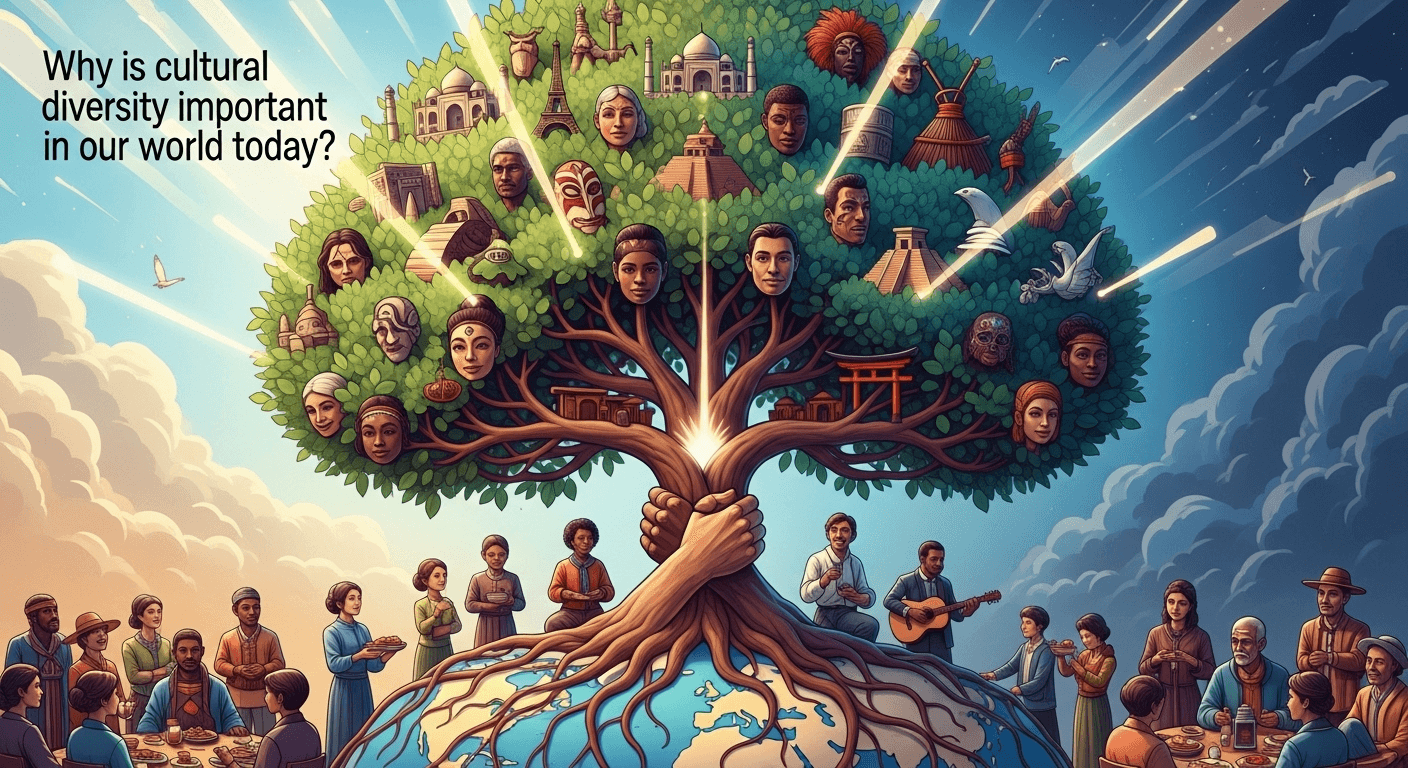Why Is Cultural Diversity Important in Our World Today?
Cultural diversity is more than a social talking point — it is a dynamic force shaping economies, education, creativity, and social cohesion. Many people ask why is cultural diversity important and the answer touches every layer of modern life: from how teams solve problems to how nations adapt to global change. Understanding the concrete benefits and practical challenges of cultural diversity helps individuals, organizations, and policymakers make better decisions that foster inclusion and long-term resilience.
Table of Contents
ToggleEconomic Advantages of Cultural Diversity
Cultural diversity fuels innovation, creates competitive advantages, and expands markets. When people from different backgrounds collaborate, they bring distinct perspectives, consumer insights, and problem-solving approaches. Diverse teams often spot opportunities and risks that homogeneous groups miss, which can translate into new products, services, and market strategies.
Organizations that value cultural diversity see measurable returns. For example, research across industries shows a correlation between diverse leadership and improved financial performance. This is not only about numbers: diverse workforces attract talent, improve employee retention, and strengthen employer branding in global markets. Companies operating internationally benefit from staff who understand local customs, languages, and consumer preferences.
At the macro level, culturally diverse countries can leverage migration and multicultural communities to address labor shortages, stimulate entrepreneurship, and sustain demographic vitality. As populations age in many regions, diversity helps maintain productive labor forces and supports continued economic growth.
Innovation and Creativity
Diverse cultural perspectives drive creative synthesis. When collaborators represent multiple cultural frames, they can combine ideas in original ways, producing breakthroughs in design, technology, and service delivery. Studies in cognitive diversity show that varied viewpoints reduce groupthink and foster critical debate.
Furthermore, cross-cultural collaboration encourages experimentation. Teams that welcome difference are more likely to test multiple approaches and iterate quickly. This iterative environment is conducive to innovation, particularly in sectors like tech, media, and design where adaptive thinking is central.
Finally, creativity rooted in cultural diversity resonates with broader audiences. Products and campaigns informed by multicultural insights often perform better in global markets because they reflect authentic, localized narratives.
Market Access and Competitive Edge
Cultural competence opens doors to new customers. Employees who understand local languages, customs, and values can craft offerings that are culturally relevant and respectful, avoiding missteps that alienate consumers. This competence is a strategic asset for companies expanding into emerging markets.
Diverse leadership teams also enable more nuanced risk assessment in unfamiliar contexts. They can evaluate regulatory, cultural, and consumer risks with greater sensitivity, helping businesses adapt strategies faster and more effectively.
To capitalize on these advantages, firms should embed cultural intelligence training and diverse hiring practices into core business strategies, aligning talent with long-term global goals.
Social and Civic Benefits
Cultural diversity strengthens social fabrics when inclusion is actively cultivated. Societies that embrace pluralism often show higher social capital, greater tolerance, and more resilient communities. Diversity encourages empathy and cross-cultural understanding, reducing prejudices and strengthening civic participation.
Education systems that include multiple cultural narratives help youth develop critical thinking and respect for difference. Multicultural curricula and language learning foster social mobility and prepare future citizens for global interconnectedness. Civic institutions that reflect population diversity enhance democratic legitimacy and ensure policies consider varied lived experiences.
However, reaping social benefits requires intentional policies: equitable resource distribution, anti-discrimination laws, and platforms for underrepresented voices. Without these supports, diversity can lead to fragmentation rather than cohesion.
Building Social Cohesion
Social cohesion grows when diverse groups have meaningful interactions based on equality and mutual respect. Programs that encourage community engagement—shared projects, intercultural festivals, and multilingual public services—create opportunities for relationship-building across differences.
Media and public education play a crucial role in normalizing diversity. Positive representation of multiple cultures reduces stereotypes and fosters a shared sense of belonging. When people see themselves reflected in institutions, they are likelier to engage and trust public systems.
Finally, conflict prevention benefits from inclusive spaces for dialogue. Mechanisms such as community councils, restorative justice models, and participatory budgeting invite diverse perspectives into problem-solving, reducing tensions and increasing legitimacy.
Democracy, Rights, and Representation
Diversity in public offices and civic organizations enhances democratic responsiveness. When policymakers represent varied communities, they are more likely to craft policies that meet a wide range of needs—education, health, housing, and labor.
Protections for minority rights and anti-discrimination measures ensure that cultural diversity translates into equal opportunity. Legal frameworks that uphold freedom of expression and religious practice create stable environments where cultural plurality can thrive.
Participation must be supported by accessible civic processes—language assistance, voter education tailored to different communities, and outreach initiatives. These measures close gaps in representation and engagement.
Educational and Cognitive Benefits
Exposure to cultural diversity in education expands cognitive flexibility and prepares learners for a globalized world. Schools that embrace multicultural classrooms promote higher-order thinking, empathy, and communication skills. Students who interact with peers from varied backgrounds develop better conflict-resolution abilities and cross-cultural competence.
Language learning is a major advantage: bilingual or multilingual individuals often show cognitive benefits, including enhanced executive function and creativity. In addition, curricula that integrate global perspectives encourage students to analyze complex systems and challenge ethnocentric assumptions.
Institutions that prioritize inclusivity—through scholarships, multicultural programming, and teacher training—help reduce achievement gaps and create pathways to higher education and leadership for marginalized groups.
Cognitive and Social Skills from Diverse Learning Environments
Classrooms with cultural diversity provide real-world practice in collaboration across difference. Students learn to negotiate meanings, navigate ambiguity, and respect alternative viewpoints. These skills are increasingly valued in knowledge economies where teamwork and innovation are critical.
Research indicates that students in diverse settings develop greater critical thinking and problem-solving skills. Exposure to multiple perspectives forces learners to evaluate evidence more thoroughly and question assumptions—capabilities essential for responsible citizenship and complex decision-making.
Teachers equipped with culturally responsive pedagogy can turn diversity into instructional strength, using varied cultural references to make learning more relevant and effective.
Language, Identity, and Lifelong Learning
Maintaining heritage languages benefits cognitive development and cultural identity. Bilingualism supports academic achievement and fosters intergenerational connections. Education systems that support multilingual instruction recognize cultural assets rather than viewing non-dominant languages as deficits.
Lifelong learning programs that incorporate cultural exchange—study abroad, virtual cultural exchanges, and community workshops—expand access to global knowledge. These programs encourage adaptability and continuous skill development across careers.
Cultural Diversity and Global Challenges
Many global challenges—climate change, migration, public health—require culturally informed responses. Cultural diversity brings varied local knowledge and adaptive strategies essential for managing complex problems. Indigenous and local knowledge systems, for instance, offer insights into sustainable land management and biodiversity conservation.
International cooperation benefits when diverse cultural perspectives inform policy design. Multilateral dialogues that genuinely include perspectives from the Global South, indigenous communities, and migrant groups produce more equitable and effective solutions.
Yet, cultural differences can complicate coordination. Successful global action depends on respectful intercultural communication, equitable policy frameworks, and mechanisms that value different knowledge systems equally.

Environmental Stewardship and Indigenous Knowledge
Indigenous communities often hold deep ecological knowledge honed over generations. Incorporating this knowledge into environmental policy can improve conservation outcomes and offer sustainable livelihood models. Recognizing and protecting traditional land rights is both an ethical and practical step toward resilience.
Cross-cultural collaboration in conservation projects enhances legitimacy and local buy-in. When local actors help define goals and methods, interventions are more likely to be culturally appropriate and sustainable.
Global frameworks like UNFCCC and various biodiversity agreements increasingly acknowledge the role of indigenous and local knowledge in climate adaptation and mitigation strategies.
Public Health, Migration, and Crisis Response
Culturally sensitive public health approaches improve outreach and compliance. During crises, messages tailored to cultural norms and delivered through trusted community leaders are more effective. Diverse health workforces improve access and trust among minority groups.
Migration introduces both challenges and opportunities for health systems. Integrating culturally competent care—language services, culturally adapted health education—helps ensure equitable outcomes and reduces disparities.
Challenges, Risks, and Practical Steps for Inclusion
While cultural diversity has many benefits, it is not a panacea. Mismanaged diversity can exacerbate inequality, trigger social tensions, or produce tokenistic inclusion. The key is deliberate, sustained efforts to build inclusive institutions and policies that level the playing field.
Effective strategies include anti-discrimination legislation, inclusive hiring practices, equity-focused education, and platforms for dialogue. Monitoring and accountability mechanisms—data collection on representation, regular impact assessments, and transparent reporting—help measure progress and guide adjustments.
Organizations and societies that treat diversity as an ongoing strategic priority rather than a one-off project are better positioned to convert cultural variety into durable advantages.
Common Risks and How to Mitigate Them
Risks include social fragmentation, unequal access to resources, and symbolic inclusion without real power (tokenism). Mitigation requires systemic approaches: redistribute resources, ensure fair representation, and create career paths for underrepresented groups.
Conflict can arise from rapid demographic change or perceived threats to identity. Policies that promote social mixing, shared public spaces, and intercultural education reduce fear and promote mutual understanding.
Data transparency and independent oversight ensure that inclusion initiatives are more than performative. Regular stakeholder consultation keeps strategies grounded in community needs.
Practical Steps for Organizations and Governments
Organizations should implement:
- Targeted recruitment and retention programs
- Cultural competence training
- Mentorship and sponsorship for diverse talent
- Inclusive product/service design processes
Governments should focus on:
- Enacting and enforcing anti-discrimination laws
- Funding multilingual education and public services
- Supporting cultural heritage initiatives
- Ensuring representation in public institutions
These steps create feedback loops that reinforce inclusion, build trust, and generate measurable outcomes.
Table: Comparative Benefits of Cultural Diversity (Selected Indicators)
| Area | Primary Benefit | Example Indicator | Typical Outcome |
|---|---|---|---|
| Economic | Innovation & Market Access | Greater likelihood of above-median financial returns (diverse leadership) | New products, expanded markets |
| Social | Cohesion & Participation | Higher civic engagement and representation | Stronger democratic legitimacy |
| Education | Cognitive Flexibility | Higher critical thinking; bilingualism benefits | Improved student outcomes |
| Environment | Local Knowledge Integration | Indigenous stewardship practices | Better conservation results |
| Public Health | Culturally tailored outreach | Improved uptake of health services in minority groups | Reduced disparities |
Implementation: Turning Diversity into Lasting Value
Transforming cultural diversity into long-term gains requires strategy, resources, and measurement. Successful implementation blends top-down leadership with bottom-up participation, ensuring that policies are both directive and responsive.
Key metrics to track include representation across levels, retention rates, pay equity, community satisfaction scores, and the tangible outcomes of diversity-driven projects (new product launches, service uptake, policy changes). Sharing best practices across sectors and fostering cross-sector partnerships accelerates learning and impact.
Finally, storytelling and visibility matter: celebrating multicultural achievements and normalizing diverse leadership models reinforce positive norms and inspire future generations.
Leadership and Governance
Leadership must be intentional about inclusion. This includes setting measurable goals, aligning incentives, and holding leaders accountable. Governance structures—diversity councils, equity officers, and inclusive procurement policies—institutionalize attention to cultural diversity.
Transparent reporting and stakeholder engagement create trust. When leaders publicly share both successes and shortcomings, they model a learning-oriented approach that invites collaboration.
Measuring Impact and Continuous Improvement
Effective metrics combine quantitative and qualitative data. Numbers reveal representation and pay gaps; narratives capture employee and community experiences. Regular surveys, focus groups, and third-party audits provide a holistic picture.
Continuous improvement cycles—plan, act, measure, reflect—help organizations adapt. Celebrating small wins alongside systemic reforms keeps momentum and demonstrates that inclusion is an enduring priority.
FAQ (Q & A)
Q: Why is cultural diversity important for businesses?
A: Cultural diversity enhances creativity, market insight, and problem-solving, often translating into better financial performance and competitive advantage. It helps businesses enter and adapt to new markets and attract global talent.
Q: Does cultural diversity always lead to social harmony?
A: Not automatically. Diversity presents opportunities for greater understanding but can also create tensions if not supported by inclusive policies, equitable resource distribution, and spaces for intercultural dialogue.
Q: How can schools promote the benefits of cultural diversity?
A: Schools can adopt multicultural curricula, support multilingual education, train teachers in culturally responsive pedagogy, and create exchange programs that expose students to different perspectives.
Q: What role does government play in supporting cultural diversity?
A: Governments can enact anti-discrimination laws, fund multicultural programs, ensure representation in public institutions, and provide services in multiple languages to ensure equal access.
Q: How should organizations measure progress on diversity and inclusion?
A: Combine quantitative metrics (representation, retention, pay equity) with qualitative feedback (surveys, focus groups). Use regular reporting, independent audits, and adjust policies based on findings.
Conclusion
Understanding why is cultural diversity important reveals that it is central to innovation, social resilience, education, and effective responses to global challenges. Cultural diversity is not an automatic boon; it requires intentional strategies, solid governance, and continuous measurement to convert diversity into durable value. When managed well, cultural diversity enriches societies, strengthens economies, and makes institutions more adaptive and just. Embracing cultural variety is both a moral choice and a pragmatic strategy for thriving in an interconnected world.
Summary (English)
Cultural diversity matters because it drives innovation, strengthens economies, and enhances social cohesion. Diverse teams and societies benefit from broader perspectives, improved problem-solving, and better market insights. Education and multicultural experiences boost cognitive flexibility, while inclusion of indigenous and local knowledge improves environmental and public health outcomes. To realize these advantages, organizations and governments must implement inclusive policies, measure progress, and foster meaningful representation. Properly managed, cultural diversity becomes a sustainable asset that improves resilience and opportunity across communities.














